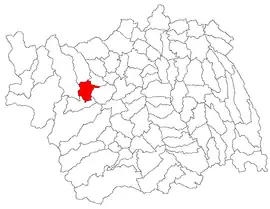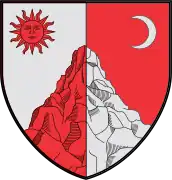Moinești
Moinești (Romanian pronunciation: [mojˈneʃtʲ]; Hungarian: Mojnest) is a city in Bacău County, Western Moldavia, Romania, with a population of 19,728 as of 2021. Its name is derived from the Romanian-language word moină, which means "fallow" or "light rain". Moinești once had a large Jewish community, and in 1899 about half of the population was Jewish;[3] in Jewish contexts the name is often given as Mojnescht or "Monesht". The city administers one village, Găzărie.
Moinești | |
|---|---|
_de_Moine%C5%9Fti.jpg.webp) Moinești City Hall | |
 Coat of arms | |
 Location in Bacău County | |
 Moinești Location in Romania | |
| Coordinates: 46°26′N 26°29′E | |
| Country | Romania |
| County | Bacău |
| Government | |
| • Mayor (2020–2024) | Valentin Vieru[1] (PNL) |
| Area | 45.83 km2 (17.70 sq mi) |
| Elevation | 400 m (1,300 ft) |
| Population (2021-12-01)[2] | 19,728 |
| • Density | 430/km2 (1,100/sq mi) |
| Time zone | EET/EEST (UTC+2/+3) |
| Postal code | 605400 |
| Area code | (+40) 02 34 |
| Vehicle reg. | BC |
| Website | www |
History
| Year | Pop. | ±% |
|---|---|---|
| 1930 | 6,616 | — |
| 1948 | 5,868 | −11.3% |
| 1956 | 12,934 | +120.4% |
| 1966 | 18,714 | +44.7% |
| 1977 | 20,862 | +11.5% |
| 1992 | 25,560 | +22.5% |
| 2002 | 25,532 | −0.1% |
| 2011 | 21,787 | −14.7% |
| 2021 | 19,728 | −9.5% |
| Source: Census data | ||
First mentioned in 1467, the locality was listed among the Moldavian villages on the Bawer map of 1783. A târg was first attested in this location in 1832; it had 188 houses and 588 inhabitants.
In 1921, Moinești was designated a comună urbană ("urban commune"), with its own coat of arms and local administration, but a step short of being considered a city. It became a municipality in 2002. The 2011 census counted 20,855 inhabitants. At the 2021 census, the city had a population of 19,728.[4]
Economy
The area around Moinești is rich in natural resources such as petroleum, natural gas, salt, and timber. Between the years 1950s and 1980s Moinești experienced a steady economic growth thanks to the large petroleum extracting industry. After 1990, however, following the nationwide industry privatization Moinești's economy changed dramatically, at some points reaching level of unemployment of over 20%.
Dada monument
In 1996, honoring Tristan Tzara, the founder of Dadaism who was born in Moinești, a monument was built on the side of the road that enters the town. It was created from concrete and steel by the German-Romanian sculptor Ingo Glass in the true Dada spirit and it is 25 meters long, 2.6 meters wide and 10 meters high and it weighs 120 tons.
Tourism
Tourist attractions in Moinești include: Băi Park (with healing mineral waters), Pine Tree Park, Ghindaru Hill (where archaeologists discovered artefacts of the pre-Cucuteni culture, over 5,000 years old), the Dada Monument (dedicated to Tristan Tzara), Cetățuia (Dacian fortified city archaeologically certified), and the Jewish Cemetery (where the oldest tombstone with recognisable text dates back to 1692).[5]
People
- Alexandru Barna, footballer
- Robert Căruță, footballer
- Hedi Enghelberg, writer
- Lăcrămioara Filip, gymnast
- Vasile Gherasim, politician
- Alexandru Margină, footballer
- Nestor Rateș, journalist, Head of Romanian Desk of Radio Free Europe 1989, 1994–2002[6]
- Moses Rosen, Chief Rabbi of Romania from 1948 to 1994
- Moshe David Shuv, born Moșe David Iancovici, early Zionist and founder of Rosh Pinna
- Tristan Tzara, writer and founder of Dada
References
- "Results of the 2020 local elections". Central Electoral Bureau. Retrieved 8 June 2021.
- "Populaţia rezidentă după grupa de vârstă, pe județe și municipii, orașe, comune, la 1 decembrie 2021" (XLS). National Institute of Statistics.
- "YIVO | Moineşti". yivoencyclopedia.org. Retrieved 2023-04-13.
- "Populația rezidentă după grupa de vârstă, pe județe și municipii, orașe, comune, la 1 decembrie 2021" (in Romanian). INSSE. 31 May 2023.
- "Moinești Tourism". 26 April 2016. Retrieved 26 April 2016.
- "Nestor Ratesh". Radio Free Europe. Retrieved 3 November 2011.
